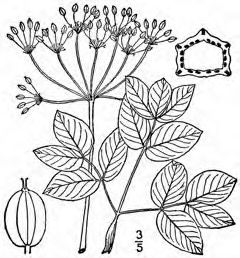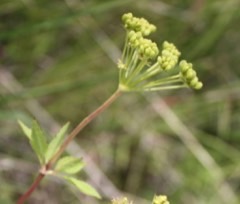 |
|
edibleplants.org |
 |
| Scott Loarie wikimedia.org |
Translate this page:
Summary
Physical Characteristics

 Taenidia integerrima is a PERENNIAL growing to 0.6 m (2ft) by 0.4 m (1ft 4in) at a fast rate.
Taenidia integerrima is a PERENNIAL growing to 0.6 m (2ft) by 0.4 m (1ft 4in) at a fast rate.
See above for USDA hardiness. It is hardy to UK zone 5.
It is noted for attracting wildlife.
Suitable for: light (sandy) and medium (loamy) soils, prefers well-drained soil and can grow in nutritionally poor soil. Suitable pH: mildly acid, neutral and basic (mildly alkaline) soils. It can grow in semi-shade (light woodland) or no shade. It prefers dry or moist soil and can tolerate drought.
UK Hardiness Map
US Hardiness Map
Synonyms
Smyrnium integerrimum L.
Plant Habitats
Edible Uses
References More on Edible Uses
Medicinal Uses
Plants For A Future can not take any responsibility for any adverse effects from the use of plants. Always seek advice from a professional before using a plant medicinally.
Native American ethnobotany. The Menominee take an infusion of root taken for pulmonary troubles, chew the steeped root for 'bronchial affections', and use it as a seasoner for other remedies because of the good smell. The Ojibwe smoke the seeds in a pipe before hunting for good luck.
References More on Medicinal Uses
The Bookshop: Edible Plant Books
Our Latest books on Perennial Plants For Food Forests and Permaculture Gardens in paperback or digital formats.

Edible Tropical Plants
Food Forest Plants for Hotter Conditions: 250+ Plants For Tropical Food Forests & Permaculture Gardens.
More

Edible Temperate Plants
Plants for Your Food Forest: 500 Plants for Temperate Food Forests & Permaculture Gardens.
More

More Books
PFAF have eight books available in paperback and digital formats. Browse the shop for more information.
Shop Now
Other Uses
Garden Uses: Woodland gardens. Native US plant gardens. Not commonly found in cultivation. Invertebrates shelter: beneficial for insects and other arthropods. Nectary: provides nectar or pollen for beneficial insects [1-2]. The flowers attract small bees, wasps (including parasitic wasps), flies, and beetles. These insects seek nectar primarily, although some bees may collect pollen and some flies and beetles may feed on pollen. Some of the fly visitors include Syrphid flies, Tachinid flies, Chloropid flies, March flies, and Blow flies, while bee visitors include Nomadine bees, Little Carpenter bees, Halictid bees, Carder bees, and Andrenid bees. The caterpillars of the butterflies Papilio polyxenes asterias (Black Swallowtail) and Papilio joanae (Ozark Swallowtail) feed on the foliage of this plant; the latter insect has not been observed in Illinois, although it has been found in Missouri and western Kentucky. Little information is available about this plant's relationships to birds and mammals as a possible food source [1-6].
Special Uses
References More on Other Uses
Cultivation details
An herbaceous perennial plant in the parsley family. The preference is partial to full sun and dry to medium conditions. Tolerates close to full shade. Poor soil is preferred, consisting of clay, rocky material, or some sand, as this reduces the competition from other plants. This plant adapts well to slopes, although it may not remain very erect. Drought resistance is very good. Bloom Time: May to July. Bloom Description: Yellow. For polyculture design as well as the above-ground architecture (form - tree, shrub etc. and size shown above) information on the habit and root pattern is also useful and given here if available. The plant growth habit is a clumper with limited spread [1-2]. The root pattern is a tap root similar to a carrot going directly down [1-2].
References Carbon Farming Information and Carbon Sequestration Information
Temperature Converter
Type a value in the Celsius field to convert the value to Fahrenheit:
Fahrenheit:
The PFAF Bookshop
Plants For A Future have a number of books available in paperback and digital form. Book titles include Edible Plants, Edible Perennials, Edible Trees,Edible Shrubs, Woodland Gardening, and Temperate Food Forest Plants. Our new book is Food Forest Plants For Hotter Conditions (Tropical and Sub-Tropical).
Shop Now
Plant Propagation
Seed. Easy.
Other Names
If available other names are mentioned here
Yellow Pimpernel
Native Range
NORTHERN AMERICA: Canada (Québec (south), Ontario), United States (Indiana, Michigan, New Jersey, New York, Ohio, Rhode Island, Vermont, West Virginia, Connecticut, Illinois, Iowa, Kansas, Minnesota, Missouri, Oklahoma, Wisconsin, Alabama, Arkansas, Delaware, Georgia, Kentucky, Louisiana, Maryland, North Carolina, South Carolina, Virginia, Mississippi, Tennessee, Texas)
Weed Potential
Right plant wrong place. We are currently updating this section.
Please note that a plant may be invasive in one area but may not in your area so it's worth checking.
None Known
Conservation Status
IUCN Red List of Threatened Plants Status : Not Listed.

Growth: S = slow M = medium F = fast. Soil: L = light (sandy) M = medium H = heavy (clay). pH: A = acid N = neutral B = basic (alkaline). Shade: F = full shade S = semi-shade N = no shade. Moisture: D = dry M = Moist We = wet Wa = water.
Now available:
Food Forest Plants for Mediterranean Conditions
350+ Perennial Plants For Mediterranean and Drier Food Forests and Permaculture Gardens.
[Paperback and eBook]
This is the third in Plants For A Future's series of plant guides for food forests tailored to
specific climate zones. Following volumes on temperate and tropical ecosystems, this book focuses
on species suited to Mediterranean conditions—regions with hot, dry summers and cool, wet winters,
often facing the added challenge of climate change.
Read More
Expert comment
Author
(L.) Drude
Botanical References
Links / References
For a list of references used on this page please go here
Readers comment
| Add a comment |
|
If you have important information about this plant that may help other users please add a comment or link below. Only comments or links that are felt to be directly relevant to a plant will be included. If you think a comment/link or information contained on this page is inaccurate or misleading we would welcome your feedback at [email protected]. If you have questions about a plant please use the Forum on this website as we do not have the resources to answer questions ourselves.
* Please note: the comments by website users are not necessarily those held by PFAF and may give misleading or inaccurate information.
To leave a comment please Register or login here All comments need to be approved so will not appear immediately.
|
Subject : Taenidia integerrima
|
|
|
|